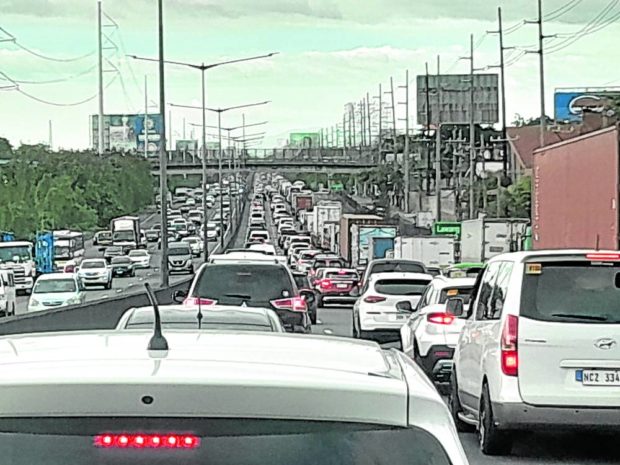
SLOW-MOVING | Vehicles along the northbound lane of North Luzon Expressway slow down on the approach to Lawang Bato, Valenzuela, due to heavy volume on Dec. 19, a few days leading to Christmas. (Photo by CARMELA REYES-ESTROPE / Inquirer Central Luzon)
BOCAUE, Bulacan, Philippines — The volume of vehicles passing through the North Luzon Expressway (NLEx) and the Subic Clark Tarlac Expressway (SCTEx) has reached a daily average of 400,000 in days leading to Christmas, prompting tollways officials to implement schemes for fast, safe, and convenient travel for northbound travelers.
The vehicle volume this Christmas season is 12 percent higher compared to the regular daily average of 300,000 to 350,000 vehicles, according to data from the Traffic Operations Department of NLEx.
On Monday, still four days before the expected Dec. 23 holiday rush, motorists had to slow down in the southbound and northbound lanes of NLEx in Bocaue, Marilao and City of Meycauayan in Bulacan during the morning and afternoon rush hours due to the volume of vehicles.
Robin Ignacio, head of the Traffic Operations Department of NLEX, said in a phone interview Monday that motorists should expect bumper-to-bumper situation due to the Christmas rush.
Traffic during this season is particularly heavy during rush hours due to slow moving vehicles and long queues in the tollways’ cash lanes, he said.In 2019 before the COVID-19 pandemic hit, the daily regular traffic volume in NLEx was at 320,000 to 330,000, Ignacio said. It went down to 120,000 to 200,000 in 2020 or at the onset of the pandemic and in 2021, he added.
Cash toll booths
Ignacio said that temporary booths and moving personnel will be deployed outside the six cash toll booths in Bocaue (southbound) and Balintawak (northbound) toll plazas during peak of the holiday rush from 6 a.m. of Dec. 23 until 6 a.m. of Dec. 26 and from 6 a.m. of Jan. 1 to 6 a.m. of Jan. 3, 2023 to ease congestion.
Kit Ventura, NLEx assistant vice president for corporate communications, in a separate interview, said that the holiday rush hour scheme was part of their “Safe Trip Mo Sagot Ko” program where they will also closely monitor the Balintawak interchanges and toll booths in Metro Manila (Mindanao Avenue, Karuhatan, Valenzuela), Bulacan (Meycauayan, Marilao, Bocaue, Sta. Rita, Pulilan), Pampanga (San Simon, San Fernando, Clark South), Tarlac, and the Bataan-Zambales area (Tipo and Subic Freeway Expressway).
The six to eight cash lanes of the 31 Bocaue toll booths have the longest queues of motorists during peak hours. Balintawak toll plaza has 23 toll booths, including its six cash lanes.
While 70 percent of the regular users of the NLEx already have radio frequency identification (RFID), those without RFID still create queues in the cash lanes which affect the overall traffic situation, particularly at the approach areas of the toll booths, Ignacio said.
“As more people are expected to gather and celebrate this festive season, more motorists are also expected to travel. We would like to encourage them to take their trips during nonpeak hours and use RFID for faster transactions at the toll plazas,” said NLEX Corp. president and general manager J. Luigi Bautista in a statement Monday.
Motorist assistance
Ventura said more than 1,000 patrol crew, traffic marshals, security teams, and toll lane personnel will be deployed to assist motorists and ensure efficient traffic flow. Emergency medical services and incident response teams will also be positioned at strategic areas.
Except for the Candaba Viaduct repairs, construction and lane closures along NLEx and SCTEx will also be suspended unless safety repairs are necessary.
High traffic volume is being anticipated in the major toll plazas of Balintawak and Mindanao Avenue on Dec. 23 (noon to midnight), Dec. 24 (6 a.m. to noon), and Dec. 29 (3 p.m. to midnight); Tarlac on Dec. 23 (2 p.m. to midnight), Dec. 24 (8 a.m. to 2 p.m.), Dec. 29 (4 p.m. to midnight), and Jan. 2 (noon to 10 p.m.); and Bocaue on Dec. 25 (2 p.m. to 10 p.m.), Dec. 29 (3 p.m. to midnight), Jan. 2 (2 p.m. to midnight), and Jan. 3 (5 a.m. to 10 a.m).